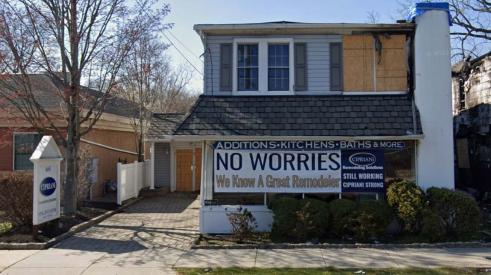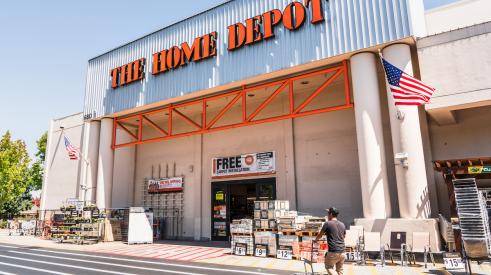|
 |
| Bio-based spray foam insulation contains no harmful or irritating micro fibers or organic dust particles. The continuous air barrier that it creates around the home not only insulates but also blocks harmful outside irritants such as mold, pollen, and other allergens, from entering the home. Photos courtesy of PATH Partners |
Your clients may not see insulation, but they sure feel it. In this age of energy efficiency, more customers are demanding better insulated homes.
Heating and cooling costs comprise more than 50 percent of the energy consumed in a single-family home. Adding the recommended levels of insulation will save energy, reduce utility costs and improve comfort.
But do you find yourself standing at the store staring at bags of pink cotton candy, blue patches of fur, and rigid pink, white and beige boards wondering which one is right for your project?
The Partnership for Advancing Technology in Housing offers some simple guidance on choosing insulation, including some popular green alternatives.
To Insulate or Not to Insulate
That is the question remodelers should consider in practically every project.
When you remodel a kitchen or bathroom, it's easy to get wrapped up in the aesthetics. But if you are ripping out drywall, it's also an opportunity to add insulation, which not only improves energy efficiency but also reduces noise and increases fire resistance.
Before you can decide if you need to add insulation, you have to determine the current level of insulation in the home and then compare that to recommended insulation levels. In many older homes, insulation levels are nonexistent, or woefully low and often poorly installed. Improper installation can completely negate the thermal resistance of the product.
 |
| Spray foam insulation expands into all the nooks and crannies in a ceiling or wall cavity, filling the cavities with insulation and sealing around utilities and other obstructions in the same step. |
Remember that thermal and air barriers must be continuous and in contact with each other. If there is a gap between the insulation and the back of the wall or ceiling drywall, the insulation is doing very little, if anything, to reduce heat loss.
The Thermal Bypass Inspection Checklist from Energy Star provides valuable guidance on all the steps needed to ensure proper installation at www.energystar.gov.
Start your inspection in the attic, then proceed to the walls and floors adjacent to unheated spaces. In older structures, structural frame elements such as the ceiling and floor joists are often exposed, allowing for easier examination. To check for wall insulation, look behind the electrical outlets, being sure to turn the power to the outlets off first. Remove the cover plate and shine a flashlight into the crack around the outlet box.
The Right R-Value for Your Project
If you find insulation, how do you know it's enough?
 |
| Air sealing with 2-part foam insulation can lights. Add insulation to attic once voids and penetrations in a home's pressure boundary are sealed. |
There is no "one-size-fits-all" recommendation. The appropriate amount depends on the climate; the type and efficiency of the heating and cooling systems; where in the home you are planning to add insulation; and how much cavity space is available to fill.
To assist you with this determination, the U.S. Department of Energy and Oak Ridge National Laboratory have developed ZIP-Code (www.ornl.gov/~roofs/Zip/ZipHome.html), which calculates insulation recommendations for your area. The program includes local weather and cost information and allows the user to add building data to improve the accuracy of the calculation.
But remember, if the insulation is poorly installed, the results mean nothing. Only proper installation ensures optimal performance. Follow manufacturer instructions to the letter, and visit the "Air Seal and Insulation" section of www.energystar.gov for more information on installation techniques.
The Right Insulation for the Job
Which insulation is best for your project?
First, familiarize yourself with the four types of insulation and their R-values before installation. Fiberglass batts and blankets have about 3.33 R-value per inch; loose fiberglass, rock wool, etc. about 3.09; blown cellulose about 3.75; open-cell foam about 4; and closed-cell foam 6 to 7 per inch. The R-value of rigid board varies with its thickness, ranging anywhere from 4 to 8 R per inch.
 |
| Fiberglass, batt insulation unrolled. Install insulation flush to walls, floors, and ceilings so the insulation is not compressed and covers the entire area. |
Batt and blanket insulation. This is the form that you're probably most familiar with. It's fairly easy to work with and is generally the least expensive. However, it doesn't air seal as well as other types and requires careful installation to insulate effectively.
Batt insulation usually consists of mineral fiber, either fiberglass or rock wool. It's used to insulate below floors, above ceilings and within walls and is best suited for standard stud and joist spacing that is relatively free of obstructions.
When installing, be sure that electrical wires; boxes for receptacle or light switches; plumbing pipes; and ducts do not compress batts. Slice the batts so the insulation can be formed around these obstructions uncompressed. Cut the insulation so it fits neatly around electrical boxes. Stuff spare insulation between the back of electrical boxes and the wall sheathing.
During installation, staple flanges to the face of the wall studs that face the living space, not to the inside. Most insulators "side staple" to leave the studs uncovered. Face stapling also makes it impossible to glue the drywall to the studs or joist. Doing it right takes lots of coordination between the two trades.
Don't leave voids. Voids of as little as 5 percent can reduce the overall R-value of the wall or ceiling by up to 50 percent.
Loose-fill insulation. Loose fibers of rock wool, fiberglass or cellulose can be blown into building cavities or attics using special equipment. Generally, it costs more than batts, but, especially in the case of cellulose, it reduces air leakage in wall cavities if blown in at sufficient density and has better sound reduction qualities. Also, it is well-suited for areas that are hard to reach or have notable obstructions.
Cellulose fiber, made from recycled newspapers, is chemically treated for fire and insect resistance. It can be installed in walls, floors or attics using a dry-pack process or a moist-spray technique. If you're doing it yourself, be sure that the bags are clearly labeled to indicate federal specifications for fire resistance.
When blowing into open wall cavities that are not covered by wallboard, use a Blow-in Blanket System (BIBS) to keep the insulation in place.
Rigid board insulation. Made from fiberglass, polystyrene and polyurethane, rigid insulation is used for reroofing work on flat roofs, on basement walls, as perimeter insulation at concrete slab edges and in cathedral ceilings. Interior applications must be covered with 12-inch gypsum board or other building-code approved material for fire safety. When rigid foam board is used to insulate the interior of masonry walls, it does not require extra vapor retarder treatment. Exterior applications must be covered with weatherproof facing. Check local codes to determine other requirements.
Spray foam. Spray foam insulation is a two-part liquid containing a polymer, such as polyurethane or modified urethane, and a foaming agent. The liquid is sprayed through a nozzle into wall, ceiling and floor cavities. It expands into a solid cellular plastic with millions of tiny air-filled cells that fill every nook and cranny.
Spray foam insulation should only be applied by professionals, and materials and installation cost more than traditional batt insulation. However, spray foam acts as both insulation and an air barrier; it eliminates the usual air-tightness detailing steps, such as caulking; applying housewrap and vapor barriers; and taping joints. This can make spray foam cost-competitive with batt insulation. Spray foam in small containers may be appropriate when replacing windows or for other jobs. For windows and doors, use products that remain soft and don't bow the frames.
For a more detailed description of these insulation types, visit PATH's Technology Inventory at www.toolbase.org.![]()
Scott T. Shepherd writes about better building practices on behalf of the Partnership for Advancing Technology in Housing (PATH). PATH is administered by the U.S. Department of Housing and Urban Development. Learn more at www.pathnet.org
| Form | Insulation Materials | Where Applicable | Installation Method(s) | Advantages |
| Blanket: batts and rolls | Fiberglass Mineral (rock or slag) Wool Plastic fibers Natural fibers |
Unfinished walls, including foundation walls and floors and ceilings | Fitted between studs, joists and beams | Do-it-yourself; suited for standard stud and joist spacing, which is relatively free from obstructions |
| Foam board or rigid foam | Polystyrene Polyisocyanurate or Polyiso Polyurethane | Unfinished walls, including foundation walls; floors and ceilings; unvented low-slope roofs | Interior applications: must be covered with 12-inch gypsum board or other building-code approved material for fire safety. Exterior applications: must be covered with weatherproof facing | High insulating value for relatively little thickness; can block thermal short circuits when installed continuously over frames or joists. |
| Loose fill | Cellulose Fiberglass Mineral (rock or slag) Wool |
Enclosed existing wall or open new wall cavities; unfinished attic floors; hard-to-reach places | Blown into place using special equipment; sometimes poured in | Good for adding insulation to existing finished areas, irregularly shaped areas and around obstructions |
| Sprayed foam and foamed-in-place | Cementitious Phenolic Polyisocyanurate Polyurethane | Enclosed existing wall or open new wall cavities; unfinished attic floors | Applied using small spray containers or in larger quantities as a pressure-sprayed (foamed-in-place) product | Good for adding insulation to existing finished areas, irregularly shaped areas and around obstructions |
| Source: U.S. Department of Energy/Oak Ridge National Laboratory, July 2007 | ||||
| Insulation Type | R-value Per Inch of Thickness |
| Fiberglass blanket or batt | 2.9 to 3.8 (use 3.2 in calculations) |
| High performance fiber glass blanket or batt | 3.7 to 4.3 (use 3.8) |
| Loose-fill fiber glass | 2.3 to 2.7 (use 2.5) |
| Loose-fill rock wool | 2.7 to 3.0 (use 2.8) |
| Loose-fill cellulose | 3.4 to 3.7 (use 3.5) |
| Perlite or vermiculite | 2.4 to 3.7 (use 2.7) |
| Expanded polystyrene board | 3.6 to 4 (use 3.8) |
| Extruded polystyrene board | 4.5 to 5 (use 4.8) |
| Polyisocyanurate board, unfaced | 5.6 to 6.3 (use 5.8) |
| Polyisocyanurate board, foil-faced | 7 |
| Spray polyurethane foam | 5.6 to 6.3 (use 5.9) |
| Source: U.S. Department of Energy/Oak Ridge National Laboratory, July 2007 | |
|
An overview of how to choose the best insulation for the job
Add new comment
Related Stories
4 Steps to Prep Your Business for Contraction
How a remodeling company plans ahead for the worst of times (and the best of times)
Creating a Company Fire Drill: How to Prepare for the Worst
A disastrous fire could have been a lot worse if the business wasn’t prepared for the unexpected
The Fundamentals of Growing Profitably
On this episode of Women at WIRC podcast, Nip Tuck Remodeling Owner April Bettinger shares how she plans for her company's profitable growth
3 Things to Add to Your Construction Contract—From a Lawyer
Did you know you can add these three elements to your contracts?
Study Finds Remodelers’ Net Profits Declined
How far did net profits decline and what's influencing the drop?
The Home Depot Bets on Pros Amid Predictions of Flat Sales Growth
For the first time since 2019, The Home Depot’s revenue fell short of Wall Street’s predictions amid a general softening in the home improvement market
Indicators of a Softening Market and How to Prepare
Market conditions could be changing, but don't panic. Richardson shares ways to stay on top of market conditions and how to prepare for any potential softening down the road.
Grow Your Business Through Collaboration with Remodeling Peers
Remodeling Mastery Forums offers a unique business opportuniy for remodelers












